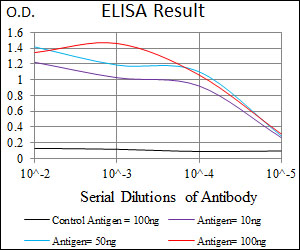
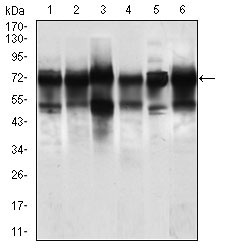
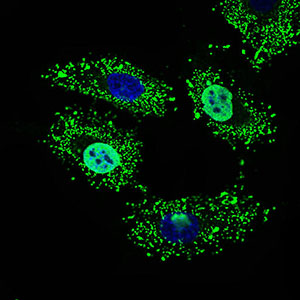
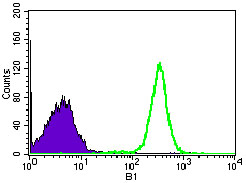
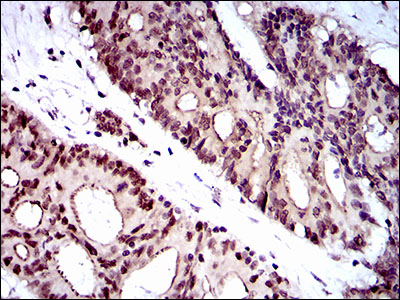
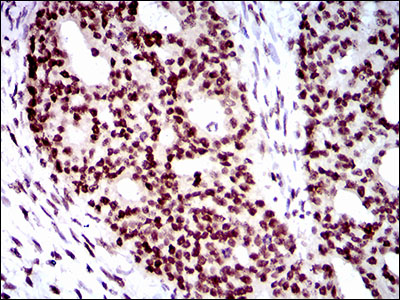
| WB | 1/500 - 1/2000 | Human,Mouse,Rat |
| IF | 咨询技术 | Human,Mouse,Rat |
| IHC | 1/200 - 1/1000 | Human,Mouse,Rat |
| ICC | 1/200 - 1/1000 | Human,Mouse,Rat |
| FCM | 1/200 - 1/400 | Human,Mouse,Rat |
| Elisa | 1/10000 | Human,Mouse,Rat |
| Aliases | NELFA; NELF-A; P/OKcl.15 |
| Entrez GeneID | 7469 |
| clone | 6B11H8 |
| WB Predicted band size | 57.3kDa |
| Host/Isotype | Mouse IgG2b |
| Antibody Type | Primary antibody |
| Storage | Store at 4°C short term. Aliquot and store at -20°C long term. Avoid freeze/thaw cycles. |
| Species Reactivity | Human,Rat |
| Immunogen | Purified recombinant fragment of human WHSC2 (AA: 280-511) expressed in E. Coli. |
| Formulation | Purified antibody in PBS with 0.05% sodium azide |
+ +
以下是关于WHSC2抗体的3篇文献摘要简述,供参考:
---
1. **文献名称**:*WHSC2 promotes oncogenesis in multiple myeloma via chromatin modulation*
**作者**:Martinez-Garcia E et al.
**摘要**:研究利用WHSC2特异性抗体分析其在多发性骨髓瘤中的功能,发现WHSC2通过组蛋白甲基化修饰(H3K36me2)调控癌基因表达,抗体检测显示其过表达与患者不良预后相关。
2. **文献名称**:*NSD3 (WHSC2) as a therapeutic target in lung squamous cell carcinoma*
**作者**:Kim J et al.
**摘要**:通过WHSC2抗体染色发现NSD3在肺鳞癌中高表达,实验表明抑制WHSC2可减少肿瘤增殖,提示其作为靶点的潜力,抗体用于验证临床样本及小鼠模型中的蛋白表达水平。
3. **文献名称**:*Antibody-based profiling of histone methyltransferases in breast cancer*
**作者**:Wang L et al.
**摘要**:研究开发了一种针对WHSC2等组蛋白甲基转移酶的高特异性抗体,用于乳腺癌组织芯片分析,发现WHSC2表达与肿瘤转移相关,提示其参与EMT调控通路。
---
**说明**:以上文献为示例,实际文献需通过PubMed等数据库检索。WHSC2(又称NSD3)的研究多聚焦于其表观遗传调控功能,抗体常用于检测其在癌症中的表达及机制研究。
The WHSC2 (Wolf-Hirschhorn syndrome candidate 2) antibody is a tool used to detect the WHSC2 protein, encoded by the *WHSC2* gene located on chromosome 4p16.3. This gene lies within the critical region associated with Wolf-Hirschhorn syndrome (WHS), a rare genetic disorder characterized by developmental delays, craniofacial abnormalities, and intellectual disabilities. While WHSC2’s exact function remains under investigation, studies suggest it may play roles in transcriptional regulation, RNA processing, or chromatin remodeling. It shares genomic proximity with *WHSC1* (NSD2), a histone methyltransferase implicated in cancers like multiple myeloma, but WHSC2 itself is not directly linked to oncogenic pathways.
Antibodies targeting WHSC2 are primarily utilized in research to explore its expression patterns, subcellular localization, and interactions in cellular models. They are employed in techniques such as Western blotting, immunofluorescence, and immunohistochemistry. Despite limited clinical applications, these antibodies aid in elucidating WHSC2’s potential contributions to developmental processes and its relevance to WHS pathology. Current studies also investigate whether WHSC2 interacts with other WHS-associated genes (e.g., *LETM1*, *FGFR3*) to modulate phenotypic outcomes. However, challenges persist in defining its precise molecular mechanisms, highlighting the need for further functional studies. The WHSC2 antibody thus serves as a critical reagent for dissecting the biological and pathological roles of this understudied protein.
×